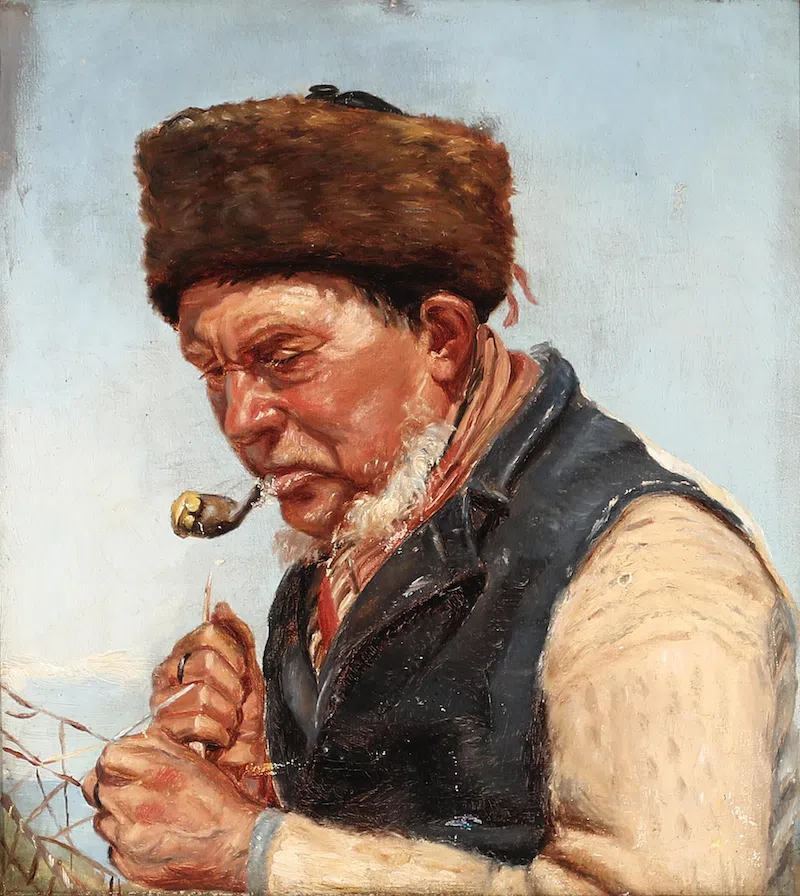View this post on Instagram
The year leading up to Vincent van Gogh’s death in 1890 was one of profound turbulence. In 1889, the artist committed himself to a psychiatric asylum in Southern France, where he created some 150 paintings, including Starry Night and Irises. An extensive new study reveals there could be yet another work to add to that list.
For years, the art research firm LMI Group International has investigated a painting originally bought by an antiques collector at a Minnesota garage sale for under $50. The painting depicts a white-bearded fisherman by the sea, a pipe dangling from his lips as he repairs a fishing net. His face is marred by ruddiness and deep smile lines, his gaze pensive and almost downtrodden. In the painting’s bottom-right corner is the name Elimar.
The collector was originally intrigued by the painting’s impasto, a stylistic technique characterized by thickly laid paint. In 2019, the work was sold to LMI Group for an undisclosed sum, leading to a multi-year research project in collaboration with LMI Group and some of the world’s most distinguished art historians and scientists. The result? A 450-page report concluding that the painting is, in fact, attributable to Van Gogh.
While residing in the asylum, Van Gogh experimented with what he called “translation,” a process in which he reinterpreted paintings by other artists through his signature color palettes and brushstrokes. He was “not copying pure and simple,” he wrote to his brother Theo, but rather “translating into another language, the one of colors, the impressions of chiaroscuro and white and black.”
According to LMI Group’s report, Elimar serves as a captivating example of a Van Gogh translation, appearing to be inspired by Danish artist Michael Ancher’s portrait of fisherman Niels Gaihede.
“Elimar is based on a painting by Michael Ancher, a popular Danish artist from the Skagen artist’s colony, a group to which Van Gogh was linked by Mette Sophie Gauguin, the Danish wife of Van Gogh’s friend and artist Paul Gauguin,” LMI Group writes in a statement. The group adds that the hard-working fisherman was a “subject to which both Gauguin and Van Gogh were drawn.”
“As soon as we saw the Ancher, I knew we were right,” William Havlicek, an art historian and LMI Group researcher, tells The Wall Street Journal.
The Ancher painting isn’t the only piece of evidence tying Elimar to Van Gogh. A hair embedded in the artwork was recovered and tested, revealing through genetic analysis that it belonged to someone with red or red-brown hair. Van Gogh’s numerous self-portraits depict the artist with ginger locks.
Researchers also found that the letters in the work’s Elimar inscription matched those in an 1885 work featuring a Bible and a book by Émile Zola, especially the Es, Ms, and As. Though Van Gogh rarely signed his paintings, the name “Elimar” nevertheless proved significant in absence of a traditional signature. LMI Group notes that Elimar is one of the characters in the 1848 novel The Two Baronesses by Hans Christian Andersen, one of Van Gogh’s favorite authors.
“Andersen was one of Van Gogh’s favorite authors, and the reference connects the painting to themes of life at sea and underscores Van Gogh’s voracious appetite for reading throughout his life,” LMI Group writes.
The materials used within the painting are all compatible with a 19th-century attribution as well, including an egg-white temporary finish that Van Gogh often used to protect his canvases as he rolled them. Evidence of Elimar having been rolled was ultimately confirmed.
The Van Gogh Museum in Amsterdam has seen the painting before: the anonymous buyer submitted it in 2019, but experts determined it wasn’t an authentic Van Gogh. The museum has yet to respond to LMI Group’s new findings.
“At the end of the day, the most important thing is what the experts in Van Gogh think of the artwork,” Robert Snell, co-owner and fine arts specialist at Revere Auctions in St. Paul, tells KARE.
LMI Group plans to showcase the painting to various Van Gogh scholars and experts in the coming months. They’ve estimated the painting to be worth $15 million, which is 300,000 times that of its original garage sale price tag.
To learn more about these incredible findings, read the full LMI Group report.
New research shows that a painting originally bought at a garage sale for under $50 is actually a Van Gogh work worth $15 million.
View this post on Instagram
Van Gogh’s Elimar was most likely a “translation” of Danish artist Michael Ancher’s portrait of fisherman Niels Gaihede.

Michael Ancher, “Fisherman Niels Gaihede reparing a fishing net.” (Photo: Bruun Rasmussen via Wikimedia Commons, Public domain)
LMI Group International: Website | Instagram
Sources: Lost Vincent Van Gogh Painting Discovered; Someone Bought This Painting at a Garage Sale for $50. Experts Say It’s a Lost van Gogh Worth $15 Million; A $50 painting at a Minnesota garage sale could be a $15 million Van Gogh
Related Articles:
Missing Medieval Chess Piece Discovered in Family Home After 200 Years, Now Worth Nearly $1M
Spanish Painting Hidden for 140 Years Is Now on Public View for the First Time Ever
Rare Caravaggio Painting Emerges and Is Publicly Displayed for the First Time Ever
